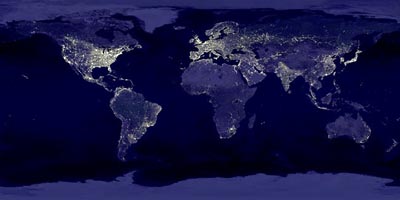 |
| NOAA/NGDC/DMSP Digital Archive | | Composite satellite images of Earth at night. |
 |
Two-thirds of Americans cannot see the Milky Way from their backyards and nearly all live in places with measurable light pollution. Dark night skies, for the first time in history, are becoming an extinct phenomenon. Researchers predict that at the current rate of increasing light pollution, by 2025 no dark skies will remain in the continental United States. The two main culprits are light and air pollution.
Light, a natural and harmless part of our world normally, is out of place at night. Light pollution is defined as the illumination of the night sky caused by artificial light, a problem born with the invention of the light bulb only 125 years ago. Most light pollution, or sky glow, is completely unneccessary and is caused by bad lighting fixtures. Many lights installed in homes, businesses, street lights and billboards are too bright and aimed upwards or sideways. The light scatters through the atmosphere above and brightens the night sky, diminishing the view of it.
Air pollution also decreases night sky visibility, just like it does in the daytime. Air pollution particles increase the scattering of light in the atmosphere, increasing sky glow.
More Than Just Aesthetics
More than simply aesthetics, light pollution is a serious problem for nocturnal animals. Many animals depend on darkness in order to hunt, conceal their location, navigate, or reproduce. Stray light disrupts their habitat, and even their life cycles. Plants, too can be affected. A tree beneath a bright street light may lose its leaves in the fall later than neighboring trees.
National Park Service Night Sky Team
National Parks harbor some of the last remaining dark skies in the country. The National Park Service Night Sky Team was formed in response to the alarming increase of light pollution even in National Parks. The team documented light from distant cities affecting night skies over 200 miles away. The lights of Las Vegas, Nevada, for example, were visible from 8 different national parks.
The Night Sky Team visited Great Basin National Park in October 2004 and 2005 and tested the light levels to determine the darkness of the night skies. The results? Great Basin's night skies are among the darkest in the country, providing visitors a rare opportunity for stargazing!
>Night Sky Quality Monitoring Reports for Great Basin
What Can You Do?
Unlike other forms of pollution, light pollution is completely reversible! A few simple changes can make a big difference. Replace outdoor lighting fixtures at home with Shielded lights, which direct all light downward, where it is needed, and block it from being needlessly projected into the night sky. Reduce the wattage of outdoor bulbs, which also provides energy savings, and use a timer or a motion sensor so lights are on only when necessary. In the evening, close blinds and drapes to prevent indoor light from escaping into the night sky. Approach local schools, businesses, and cities about replacing conventional lighting fixtures with Shielded lights for improved safety, visibility, and energy cost savings.
>Learn more about Natural Lightscapes
>International Dark Sky Association Website
| 





